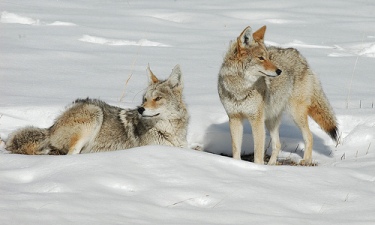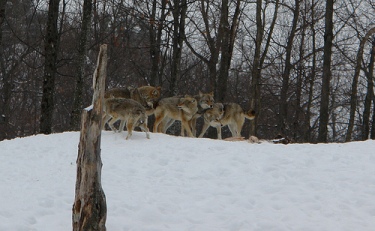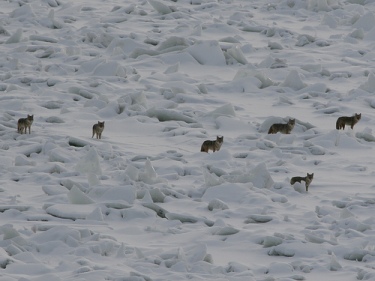
Social Structure - Family Ties
Coyotes have an important social structure, much like that
of wolves, that relies on strong family bonds and shared
territories. These packs have an alpha pair and three to
eight additional family members. The size of the pack usually
depends on the availability of food and the amount of territory
available. The alpha pair are usually the only ones to
mate unless the population is threatened, as occurs sometimes
with overhunting. Even so, it is very rare for a second
female in a single pack to have pups.
 There are two or
more beta coyotes who are responsible for defending territory
and helping to look after the pups and the mother. These
betas are siblings from a previous litter that remain with the
alpha pair after they are eight months old rather than leaving.
Some pups disperse and meet up with other dispersed animals to
form new mating pairs and packs. This rearrangement of the
pack occurs in late fall, when it is decided which of that
year’s pups will become nomadic, which will remain as members of
the pack, and which will leave to potentially begin packs of
their own in an adjacent territory.
There are two or
more beta coyotes who are responsible for defending territory
and helping to look after the pups and the mother. These
betas are siblings from a previous litter that remain with the
alpha pair after they are eight months old rather than leaving.
Some pups disperse and meet up with other dispersed animals to
form new mating pairs and packs. This rearrangement of the
pack occurs in late fall, when it is decided which of that
year’s pups will become nomadic, which will remain as members of
the pack, and which will leave to potentially begin packs of
their own in an adjacent territory.

The territory occupied by a pack varies in size depending on population density and availability of food. It can be as large as forty square miles, but most coyote territories are only about one twelfth the size of a wolf pack territory. Home ranges for rogue mating pairs and nomads are much larger, as they need to avoid established pack territories. As with most canines, scent marking is used to mark territorial borders. Often higher objects such as rocks or bushes are marked so that scent is still apparent during winter months when the snow covers the ground. Coyotes tend to avoid wandering into the territories of other packs, especially during mating season and right after pups are born when the pack is the most territorial and defensive. In more urban environments there is little pack structure, and mating pairs are often the largest group that is seen.
 There are two or
more beta coyotes who are responsible for defending territory
and helping to look after the pups and the mother. These
betas are siblings from a previous litter that remain with the
alpha pair after they are eight months old rather than leaving.
Some pups disperse and meet up with other dispersed animals to
form new mating pairs and packs. This rearrangement of the
pack occurs in late fall, when it is decided which of that
year’s pups will become nomadic, which will remain as members of
the pack, and which will leave to potentially begin packs of
their own in an adjacent territory.
There are two or
more beta coyotes who are responsible for defending territory
and helping to look after the pups and the mother. These
betas are siblings from a previous litter that remain with the
alpha pair after they are eight months old rather than leaving.
Some pups disperse and meet up with other dispersed animals to
form new mating pairs and packs. This rearrangement of the
pack occurs in late fall, when it is decided which of that
year’s pups will become nomadic, which will remain as members of
the pack, and which will leave to potentially begin packs of
their own in an adjacent territory.
The territory occupied by a pack varies in size depending on population density and availability of food. It can be as large as forty square miles, but most coyote territories are only about one twelfth the size of a wolf pack territory. Home ranges for rogue mating pairs and nomads are much larger, as they need to avoid established pack territories. As with most canines, scent marking is used to mark territorial borders. Often higher objects such as rocks or bushes are marked so that scent is still apparent during winter months when the snow covers the ground. Coyotes tend to avoid wandering into the territories of other packs, especially during mating season and right after pups are born when the pack is the most territorial and defensive. In more urban environments there is little pack structure, and mating pairs are often the largest group that is seen.